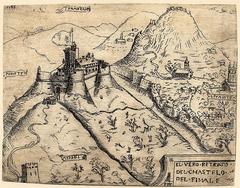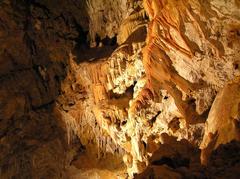
Visiting Hours, Tickets, and Historical Insights of Castel Gavone in Finale Ligure
Date: 31/07/2024
Introduction
Nestled in the enchanting medieval town of Finalborgo, Italy, Castel Gavone—also known as ‘Castrum Govonis’—stands as a testament to centuries of history, architectural ingenuity, and cultural significance. This majestic fortress, believed to have been constructed by Enrico II in 1181, offers visitors an immersive journey through time, from its medieval origins to its Renaissance transformations and beyond. The castle has witnessed numerous historical events, including conflicts with Genoese forces and subsequent reconstructions, making it a focal point of the region’s rich heritage (turismo.comunefinaleligure.it, mudifinale.com).
The architectural splendor of Castel Gavone is epitomized by the renowned ‘Diamond Tower,’ a Renaissance addition that showcases innovative military design and the use of Finale Stone. The castle’s strategic location atop Becchignolo hill, combined with its robust fortifications, made it a formidable stronghold for the Del Carretto family, who ruled the region until the early 17th century. Despite the destruction wrought by the Genoese in 1715, the ruins of Castel Gavone continue to captivate visitors, thanks to modern restoration efforts that have preserved its historical authenticity (spottinghistory.com).
This comprehensive guide aims to provide prospective visitors with all the necessary information to plan their trip to Castel Gavone. From detailed historical insights to practical travel tips, including visiting hours, ticket information, and nearby attractions, this guide ensures that your visit to this medieval marvel is both enriching and enjoyable.
Table of Contents
Historical Background
Origins and Early History
The origins of Castel Gavone, also known as ‘Castrum Govonis,’ are shrouded in mystery, with its exact construction date remaining unknown. The castle is believed to have been built by Enrico II in 1181 on the remnants of earlier defensive structures (turismo.comunefinaleligure.it). The first documented mention of the castle dates back to 1128, suggesting that it was established in the 12th century when feudal power was being organized in Finale (mudifinale.com).
Architectural Evolution
Throughout its history, Castel Gavone underwent several modifications and expansions. By 1292, the castle was fortified, indicating its strategic importance in the region (spottinghistory.com). The castle’s architecture evolved significantly over the centuries, reflecting the changing needs and tastes of its occupants. During the medieval period, the castle grew to accommodate various family members of the Del Carretto marquises, who frequently clashed and had violent contrasts (mudifinale.com).
The Del Carretto Family
Castel Gavone served as the prestigious fortified residence of the Del Carretto family, the rulers of Finale. The Del Carretto marquises were influential figures in the region, and the castle was a symbol of their power and authority. The castle’s representative rooms hosted significant events and decisions related to the marquisate. In 1390, a garden called ‘viridario’ with a cypress tree was mentioned in documents, indicating the presence of a landscaped area near the castle (mudifinale.com).
Renaissance Modifications
In the mid-15th century, Giovanni I undertook significant reconstruction efforts, rebuilding the castle along with the Borgo walls between 1451 and 1452 (spottinghistory.com). One of the most notable additions during this period was the Renaissance ‘Diamond Tower,’ characterized by its unique diamond-shaped ashlars made from Finale Stone. This tower remains one of the best-preserved structures of the castle and is an excellent example of late medieval military architecture (turismo.comunefinaleligure.it).
Conflicts and Destruction
The castle’s strategic location made it a focal point in various conflicts. It was destroyed during struggles with Genoa but was subsequently rebuilt. In the second half of the 16th century, the castle endured sieges and bombardments, reflecting the turbulent political landscape of the time (mudifinale.com). The sale of the Finale marquisate to Spain in 1602 marked the beginning of the castle’s decline. Despite its deteriorating condition, the castle continued to house Spanish governors for a while.
The Genoese Conquest
The fate of Castel Gavone was sealed with the purchase of Finale by the Republic of Genoa in 1713. Determined to erase the symbol of their ancient enemy, the Genoese dismantled the castle in 1715, leaving only some of the retaining side-walls and the Diamond Tower intact (turismo.comunefinaleligure.it). The materials from the castle, including beams, stones, and columns, were repurposed for the construction of churches, gates, and houses in the surrounding area.
Modern Restoration Efforts
In recent years, restoration efforts have been undertaken to preserve the ruins of Castel Gavone. These efforts, funded by European sources, intentionally left the signs of the 1715 Genoese destruction to create an atmosphere of historical authenticity and fascination (mudifinale.com). The restoration work has allowed visitors to appreciate the castle’s historical significance and architectural grandeur.
Significance in Military Architecture
Castel Gavone holds a prominent place in the history of Italian military architecture. The Diamond Tower, with its curved triangular base and diamond-faceted stones, is a testament to the innovative design and engineering of the period. The castle’s strategic location on a steep, curvilinear rampart atop Becchignolo hill provided a formidable defense against invaders (spottinghistory.com). The castle’s design and construction techniques influenced the development of military architecture in the region and beyond.
Cultural and Historical Legacy
Today, the majestic ruins of Castel Gavone continue to dominate the medieval town of Finale, now known as Finalborgo. The castle’s historical and cultural legacy is preserved through various initiatives, including guided tours and educational programs. Visitors can explore the castle’s remains, learn about its storied past, and appreciate its architectural splendor (mudifinale.com).
Visitor Information
Visiting Hours and Tickets
Castel Gavone is open to visitors throughout the year. However, visiting hours may vary depending on the season and special events. It is advisable to check the official website or contact local tourist information centers for the most up-to-date information on visiting hours and ticket prices. Guided tours are available and can be booked in advance through the ‘Open door Open art’ project endorsed by MUDIF (finaleoutdoor.com).
How to Get There
For those planning to visit Castel Gavone, the castle can be reached by walking or cycling from Finalborgo. Follow the Berretta road or the road to Perti Alta starting in San Sebastiano on the road to Calice Ligure (mudifinale.com). Ample signage along the way ensures visitors can find their way easily.
Nearby Attractions
Finalborgo is home to several other historical sites worth visiting. These include the Church of San Biagio, the Archaeological Museum of Finale, and the Abbey of Santa Maria. Exploring these sites provides a comprehensive understanding of the region’s rich cultural heritage.
Accessibility
While efforts have been made to preserve the castle, accessibility may be challenging for those with mobility issues due to the steep terrain and uneven surfaces. Visitors are advised to wear comfortable footwear and be prepared for a moderate hike.
Special Events and Photography
Castel Gavone hosts various special events throughout the year, from historical reenactments to cultural festivals. These events offer a unique opportunity to experience the castle in a lively and engaging setting. Additionally, the castle and its surroundings provide stunning photographic spots, perfect for capturing memories of your visit.
FAQ
Q: How do I get tickets for Castel Gavone?
A: Tickets can be purchased through the official website or at local tourist information centers. Guided tours should be booked in advance.
Q: What are the visiting hours for Castel Gavone?
A: Visiting hours vary depending on the season and special events. Check the official website or contact local tourist information centers for the latest information.
Q: What other historical sites are nearby?
A: Nearby historical sites include the Church of San Biagio, the Archaeological Museum of Finale, and the Abbey of Santa Maria.
Conclusion
Castel Gavone’s rich history, architectural significance, and cultural legacy make it a must-visit destination for history enthusiasts and tourists alike. The castle’s ruins offer a glimpse into the past, allowing visitors to connect with the region’s medieval and Renaissance heritage. Plan your visit today and immerse yourself in the captivating story of Castel Gavone.
For more updates and information, follow us on social media or download our mobile app Audiala.
References
- MUDIF. (n.d.). Gavone Castle and the Diamond Tower. mudifinale.com
- Turismo Comune Finale Ligure. (n.d.). Castel Gavone. turismo.comunefinaleligure.it
- Spotting History. (n.d.). Gavone Castle. spottinghistory.com
- Finale Outdoor. (n.d.). Gavone Castel and the Diamond Tower. finaleoutdoor.com

